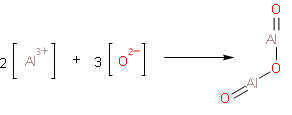
An element has atomic number 13. Which of the following statements related to this element is wrong?
A. The atom has 13 protons.
B. The element is placed in the third period of the periodic table.
C. The element is placed in group VI in the periodic table.
D. The formula of its oxide is ${{\text{X}}_{\text{2}}}{{\text{O}}_{\text{2}}}$.
Answer
594.3k+ views
Hint: The element given in the question has an electronic configuration of 2, 8, 3. So we can predict that the number of valence electrons will be 3 electrons. This information gives us an idea about the position of the element in the periodic table.
Complete step-by-step answer:
Since it is given that the element has an atomic number of 13. So it can be said that the element is Aluminium.
Let us check each of the following conditions corresponding to the atomic number.
We know that in an atom the number of electrons is equal to the number of protons. The atomic number is known as the number of electrons present in an element. So according to the question it can be said that since the atomic number of the element is 13 it means it has 13 electrons and also 13 protons. Therefore, option A is true.
The electronic configuration of Aluminium, having atomic number 13 is [Ne] $3{s^1}3{p_x}^1$. Therefore, from the electronic configuration we can say that the outer electrons are in three-level orbitals. Since they are in three level orbitals they will be placed in period 3 of the periodic table. Therefore, option B is true.
The valency of an element is determined by the number of outer shell electrons also known as valence electrons. Elements are placed in groups in the periodic table according to the number of valence electrons. Since the atomic number is 13, therefore the valency is 3. So the element will be placed in group VI. Therefore, Option C is true.
The formula of Aluminium Oxide is $A{l_2}{O_3}$ because it is present in the period 3 of the periodic table. The oxidation state is +3. The condition in the question given is wrong.
Therefore, Option D is the correct answer.
Note:

Where Al donates 6 electrons and O acquires 6 electrons
We know that the overall charge of a compound must always be equal to zero. We need 2 aluminium atoms and 3 oxygen atoms in order to balance out the charge and make the compound neutral. This means a chemical formula for aluminium oxide is simply $A{l_2}{O_3}$ . Which means we need 2 aluminium atoms for every 3 oxygen atoms.
Complete step-by-step answer:
Since it is given that the element has an atomic number of 13. So it can be said that the element is Aluminium.
Let us check each of the following conditions corresponding to the atomic number.
We know that in an atom the number of electrons is equal to the number of protons. The atomic number is known as the number of electrons present in an element. So according to the question it can be said that since the atomic number of the element is 13 it means it has 13 electrons and also 13 protons. Therefore, option A is true.
The electronic configuration of Aluminium, having atomic number 13 is [Ne] $3{s^1}3{p_x}^1$. Therefore, from the electronic configuration we can say that the outer electrons are in three-level orbitals. Since they are in three level orbitals they will be placed in period 3 of the periodic table. Therefore, option B is true.
The valency of an element is determined by the number of outer shell electrons also known as valence electrons. Elements are placed in groups in the periodic table according to the number of valence electrons. Since the atomic number is 13, therefore the valency is 3. So the element will be placed in group VI. Therefore, Option C is true.
The formula of Aluminium Oxide is $A{l_2}{O_3}$ because it is present in the period 3 of the periodic table. The oxidation state is +3. The condition in the question given is wrong.
Therefore, Option D is the correct answer.
Note:

Where Al donates 6 electrons and O acquires 6 electrons
We know that the overall charge of a compound must always be equal to zero. We need 2 aluminium atoms and 3 oxygen atoms in order to balance out the charge and make the compound neutral. This means a chemical formula for aluminium oxide is simply $A{l_2}{O_3}$ . Which means we need 2 aluminium atoms for every 3 oxygen atoms.
Recently Updated Pages
Master Class 11 Economics: Engaging Questions & Answers for Success

Master Class 11 English: Engaging Questions & Answers for Success

Master Class 11 Social Science: Engaging Questions & Answers for Success

Master Class 11 Biology: Engaging Questions & Answers for Success

Class 11 Question and Answer - Your Ultimate Solutions Guide

Master Class 11 Business Studies: Engaging Questions & Answers for Success

Trending doubts
10 examples of friction in our daily life

One Metric ton is equal to kg A 10000 B 1000 C 100 class 11 physics CBSE

Difference Between Prokaryotic Cells and Eukaryotic Cells

1 Quintal is equal to a 110 kg b 10 kg c 100kg d 1000 class 11 physics CBSE

Explain zero factorial class 11 maths CBSE

What is a periderm How does periderm formation take class 11 biology CBSE




